
Chain Home, or CH for short, was the codename for the ring of coastal early warning radar stations built by the Royal Air Force (RAF) before and during the Second World War to detect and track aircraft. Initially known as RDF, and given the official name Air Ministry Experimental Station Type 1 in 1940, the radar units were also known as Chain Home for most of their life. Chain Home was the first early warning radar network in the world and the first military radar system to reach operational status. Its effect on the war made it one of the most powerful systems of what became known as the "Wizard War".

Direction finding (DF), or radio direction finding (RDF), is the use of radio waves to determine the direction to a radio wave source. The source may be a cooperating radio transmitter or may be an inadvertant source, a naturally-occurring radio source, or an illicit or enemy system. Radio direction finding differs from radar in that only the direction is determined by any one receiver; a radar system usually also gives a distance to the object of interest, as well as direction. By triangulation, the location of a radio source can be determined by measuring its direction from two or more locations. Radio direction finding is used in radio navigation for ships and aircraft, to locate emergency transmitters for search and rescue, for tracking wildlife, and to locate illegal or interfering transmitters. During the Second World War, radio direction finding was used by both sides to locate and direct aircraft, surface ships, and submarines.

Freya was an early warning radar deployed by Germany during World War II; it was named after the Norse goddess Freyja. During the war, over a thousand stations were built. A naval version operating on a slightly different wavelength was also developed as the Seetakt.
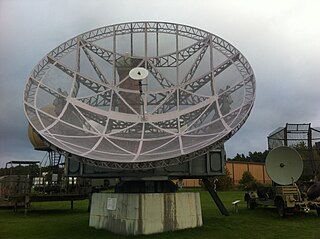
The low-UHF band Würzburg radar was the primary ground-based tracking radar for the Wehrmacht's Luftwaffe and Kriegsmarine during World War II. Initial development took place before the war and the apparatus entered service in 1940. Eventually, over 4,000 Würzburgs of various models were produced. It took its name from the city of Würzburg.
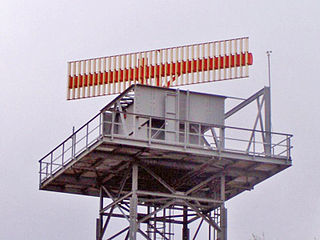
Secondary surveillance radar (SSR) is a radar system used in air traffic control (ATC), that unlike primary radar systems that measure the bearing and distance of targets using the detected reflections of radio signals, relies on targets equipped with a radar transponder, that reply to each interrogation signal by transmitting encoded data such as an identity code, the aircraft's altitude and further information depending on its chosen mode. SSR is based on the military identification friend or foe (IFF) technology originally developed during World War II; therefore, the two systems are still compatible. Monopulse secondary surveillance radar (MSSR), Mode S, TCAS and ADS-B are similar modern methods of secondary surveillance.

Seetakt was a shipborne radar developed in the 1930s and used by the German Navy (Kriegsmarine) during World War II. It is the first naval radar to enter service, and among the earlest radars of any sort. It provided range measurements with an accuracy on the order of 50 metres (160 ft), more than enough for gunnery. Its angle accuracy was not very good, but the development of lobe switching specifically for this radar provided about 1 degree accuracy, not enough to directly lay the guns, but still useful for initial plotting and aiding the optical spotters find their target.

Sodar, an acronym of sonic detection and ranging, is a meteorological instrument used as a wind profiler based on the scattering of sound waves by atmospheric turbulence. Sodar equipment is used to measure wind speed at various heights above the ground, and the thermodynamic structure of the lower layer of the atmosphere.

Chain Home Low (CHL) was the name of a British early warning radar system operated by the RAF during World War II. The name refers to CHL's ability to detect aircraft flying at altitudes below the capabilities of the original Chain Home (CH) radars, where most CHL radars were co-located. CHL could reliably detect aircraft flying as low as 500 feet (150 m). The official name was AMES Type 2, referring to the Air Ministry Experimental Station at Bawdsey Manor where it was developed, but this name was almost never used in practice.

A radar display is an electronic device that presents radar data to the operator. The radar system transmits pulses or continuous waves of electromagnetic radiation, a small portion of which backscatter off targets and return to the radar system. The receiver converts all received electromagnetic radiation into a continuous electronic analog signal of varying voltage that can be converted then to a screen display.
Radar in World War II greatly influenced many important aspects of the conflict. This revolutionary new technology of radio-based detection and tracking was used by both the Allies and Axis powers in World War II, which had evolved independently in a number of nations during the mid 1930s. At the outbreak of war in September 1939, both the United Kingdom and Germany had functioning radar systems. In the UK, it was called RDF, Range and Direction Finding, while in Germany the name Funkmeß (radio-measuring) was used, with apparatuses called Funkmessgerät . By the time of the Battle of Britain in mid-1940, the Royal Air Force (RAF) had fully integrated RDF as part of the national air defence.
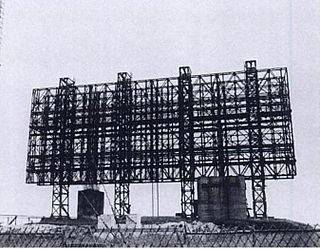
The FuMG 41/42 Mammut was a long-range, phased array, early warning radar built by Germany in the latter days of World War II. Developed by the GEMA company, it consisted of six or eight Freya antenna arrays, switched together and coupled to two Freya devices. The arrays were fixed and the beam could be electronically steered on a 100° arc in front and behind the antenna, leaving 80° blind arcs on each side. It was the world's first phased array radar and was able to detect targets flying at an altitude of 8,000m at a range of 300km.
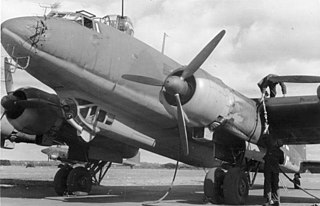
The FuG 200 Hohentwiel was a low-UHF band frequency maritime patrol radar system of the Luftwaffe in World War II. It was developed by C. Lorenz AG of Berlin starting in 1938 under the code name "Hohentwiel", an extinct volcano in the region of Baden-Württemberg in southern Germany.

Neptun (Neptune) was the code name of a series of low-to-mid-VHF band airborne intercept radar devices developed by Germany in World War II and used as active targeting devices in several types of aircraft. They were usually combined with a "backwards warning device", indicated by the addition of the letters "V/R" Vorwärts/Rückwärts, meaning Forward/Backward). Working in the metre range, Neptun was meant as a stop-gap until scheduled SHF-band devices became available.
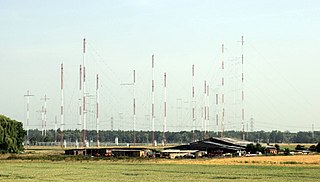
Curtain arrays are a class of large multielement directional radio transmitting wire antennas, used in the shortwave radio bands. They are a type of reflective array antenna, consisting of multiple wire dipole antennas, suspended in a vertical plane, often in front of a "curtain" reflector made of a flat vertical screen of many long parallel wires. These are suspended by support wires strung between pairs of tall steel towers, up to 90 m high. They are used for long-distance skywave transmission; they transmit a beam of radio waves at a shallow angle into the sky just above the horizon, which is reflected by the ionosphere back to Earth beyond the horizon. Curtain antennas are mostly used by international short wave radio stations to broadcast to large areas at transcontinental distances.

The TRML is a family of air defense radars first developed by Telefunken and currently produced by Hensoldt. It is a development of the earlier TRMS.

The Battle of Douvres Radar Station was a military engagement of World War II as part of the Invasion of Normandy, that took place on 17 June 1944. The attack was by British 41 Commando, Royal Marines, the station and area were defended mainly by Luftwaffe ground forces. Preceded by an artillery bombardment and supported by mine-clearing and anti-bunker tanks of 79th Armoured Division, the Royal Marines were able to secure the surrender of the garrison.
German Luftwaffe and Kriegsmarine Radar Equipment during World War II, relied on an increasingly diverse array of communications, IFF and RDF equipment for its function. Most of this equipment received the generic prefix FuG, meaning "radio equipment". During the war, Germany renumbered their radars. From using the year of introduction as their number they moved to a different numbering scheme.

The Type 277 was a surface search and secondary aircraft early warning radar used by the Royal Navy and allies during World War II and the post-war era. It was a major update of the earlier Type 271 radar, offering much more power, better signal processing, new displays, and new antennas with greatly improved performance and much simpler mounting requirements. It allowed a radar with performance formerly found only on cruisers and battleships to be fitted even to the smallest corvettes. It began to replace the 271 in 1943 and was widespread by the end of the year.

The AMES Type 7, also known as the Final GCI, was a ground-based radar system introduced during World War II by the Royal Air Force (RAF). The Type 7 was the first truly modern radar used by the Allies, providing a 360 degree view of the airspace around the station out to a distance of about 90 miles (140 km). It allowed fighter interceptions to be plotted directly from the radar display, a concept known as ground controlled intercept, or GCI.
Martello is a family of phased array radar systems developed by Marconi Electronic Systems in the 1970s and introduced operationally in the early 1980s. They provided long-range early warning capabilities but also had the accuracy needed for interception plotting and "putting on" of other weapons systems like surface-to-air missiles. The name comes from the Martello towers that provided defence in earlier years.




















